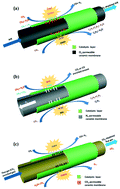Catalytic mixed conducting ceramic membrane reactors for methane conversion
Abstract
The application of catalytic mixed conducting ceramic membrane reactors shows great promise for industrial processes to produce value-added chemicals. A catalytic membrane reactor combines separation and reaction in one unit and also synergistically enhances the membrane permeability and catalyst activity, resulting in process intensification. This article presents a review on the development of O2 permeable, H2 permeable and CO2 permeable catalytic mixed conducting ceramic membrane reactors for methane conversion. The majority of such studies focus on the application of O2 permeable ceramic membrane reactors while fewer applications of H2 permeable and CO2 permeable ceramic membrane reactors have been reported. These catalytic mixed conducting ceramic membrane reactors are mainly applied in several CH4 conversion reactions, such as partial oxidation of methane (POM), steam reforming of methane (SRM), dry reforming of methane (DRM), oxidative/nonoxidative coupling of methane (OCM/NCM), and methane aromatization (MA), and bifunctional membrane reactors. The performance, advantages and challenges of catalytic membrane reactors for various reactions are summarized and discussed. Finally, the prospects and direction of future development of mixed conducting membranes for industrial application are discussed and highlighted.

- This article is part of the themed collection: Catalytic Membrane Reaction Chemistry


 Please wait while we load your content...
Please wait while we load your content...